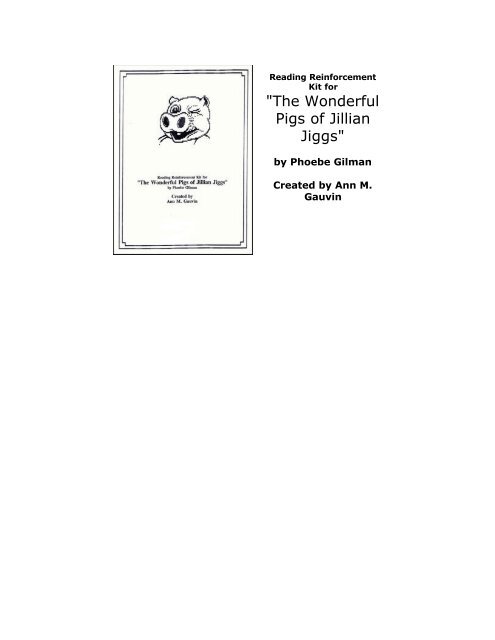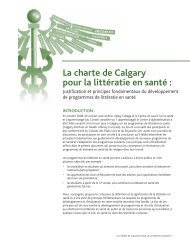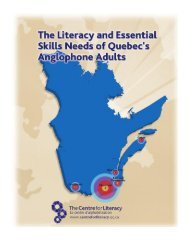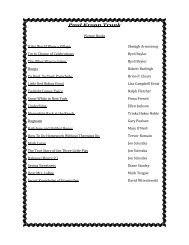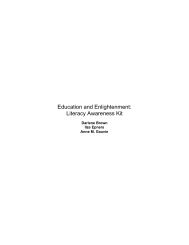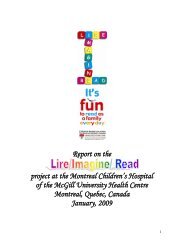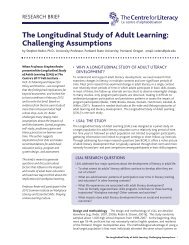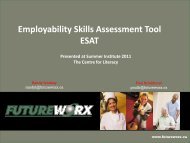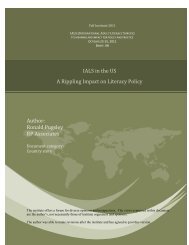The Wonderful Pigs of Jillian Jiggs - The Centre for Literacy of Quebec
The Wonderful Pigs of Jillian Jiggs - The Centre for Literacy of Quebec
The Wonderful Pigs of Jillian Jiggs - The Centre for Literacy of Quebec
Create successful ePaper yourself
Turn your PDF publications into a flip-book with our unique Google optimized e-Paper software.
Reading Rein<strong>for</strong>cement<br />
Kit <strong>for</strong><br />
"<strong>The</strong> <strong>Wonderful</strong><br />
<strong>Pigs</strong> <strong>of</strong> <strong>Jillian</strong><br />
<strong>Jiggs</strong>"<br />
by Phoebe Gilman<br />
Created by Ann M.<br />
Gauvin
Table <strong>of</strong> Contents<br />
INTRODUCTION AND INFORMATION ABOUT BOOK<br />
PRE-READING ACTIVITIES<br />
INTRODUCTION OF THE BOOK<br />
AFTER THE READING OF THE STORY<br />
ACTIVITIES PART TWO<br />
REINFORCEMENT EXERCISES FOR CONSONANT «P»<br />
CRAFTS<br />
ACKNOWLEDGEMENTS
READING REINFORCEMENT ACTIVITY KIT<br />
TITLE OF BOOK :<br />
AUTHOR/ILLUSTRATOR :<br />
PUBLISHER :<br />
<strong>The</strong> <strong>Wonderful</strong> <strong>Pigs</strong> <strong>of</strong> <strong>Jillian</strong> <strong>Jiggs</strong><br />
Phoebe Gilman<br />
http://www.phoebegilman.com<br />
Scholastic Canada Ltd.<br />
LEVEL : Grade One<br />
ISBN NUMBER :<br />
CONTENT:<br />
SPECIAL FEATURE :<br />
KIT PREPARED BY :<br />
FUNDING FOR PROJECT :<br />
0-590-74847-5<br />
Once the irrepressible <strong>Jillian</strong> <strong>Jiggs</strong> learns how to<br />
make cloth pigs, she aims to make lots <strong>of</strong><br />
money by selling them in the neighbourhood.<br />
But she discovers that she can't bear to part<br />
with her creations and instead shows others -<br />
including the reader - how to make their own<br />
pigs.<br />
<strong>The</strong>re are detailed instructions at the back <strong>of</strong> the<br />
book on how to make cloth pigs.<br />
Materials are included in this kit <strong>for</strong> this craft.<br />
Ann M. Gauvin<br />
<strong>Quebec</strong> City Reading Council<br />
(418) 658-8298<br />
Through Concerted <strong>Literacy</strong> Councils <strong>of</strong> <strong>Quebec</strong><br />
Federal/Provincial Initiatives Project
EARLY SKILLS BY GRADE<br />
In its study <strong>of</strong> reading research, Preventing Reading Difficulties in Young Children, the<br />
National Research Council has come up with a list <strong>of</strong> skills students need to master in the<br />
early grades to remain on track <strong>for</strong> reading success. Here's a glimpse:<br />
Kindergarten<br />
Can name and recognize all the letters in the alphabet.<br />
Understands that the sequence <strong>of</strong> letters in a word represents the sequence <strong>of</strong> sounds.<br />
Recognizes some simple words by sight, such as "a," "the," "my," "you."<br />
Correctly answers questions about stories read aloud.<br />
Given a set <strong>of</strong> spoken words such as "dan, dan, den," can identify the first two as the same<br />
and the last one as different.<br />
Given a set <strong>of</strong> spoken words like "dak, pat, zen," can recognize that the first two share a<br />
sound.<br />
Can come up with a word that rhymes with a spoken word.<br />
Can write his or her own name.<br />
First Grade<br />
Can read aloud and comprehend any text designed <strong>for</strong> the first half <strong>of</strong> first grade.<br />
Can sound out simple words as well as short nonsense words (sit, zot).<br />
Routinely sounds out unfamiliar words in text.<br />
Monitors own reading and self-corrects when an incorrectly read word doesn't fit with cues<br />
provided by letters in the word or context.<br />
Can count the syllables in a word.<br />
Can blend or separate the sounds that make up a word.<br />
Can answer simple written questions about a text.
Second Grade<br />
Reads and understands fiction and nonfiction at grade level.<br />
Can sound out multi syllable words with regular spellings such as capital, Kalamazoo.<br />
Sounds out unknown words.<br />
Reads many irregularly spelled words and common letter patterns such as special vowel<br />
combinations or word endings.<br />
Reads voluntarily to pursue his or her own interests or purposes.<br />
Correctly spells previously studied words.<br />
Represents all the sounds <strong>of</strong> a word when spelling.
THE WONDERFUL PIGS OF JILLIAN JIGGS<br />
PRE-READING ACTIVITIES : Have the child draw a picture <strong>of</strong> a pig<br />
DIRECTIONS : Using the example below, have the child draw and<br />
colour his pig.<br />
Find printable colouring activities at:<br />
<strong>Pigs</strong> at Enchanted Learning<br />
http://www.enchantedlearning.com/themes/pig.shtml<br />
Includes pig rhymes, crafts and printouts to colour.
THE WONDERFUL PIGS OF JILLIAN JIGGS<br />
PRE-READING ACTIVITIES : Nursery Rhymes<br />
DIRECTIONS : This activity should be theme related to the story<br />
1. Introduce the Nursery Rhyme, chants or fingerplays. If it comes from a book<br />
introduce the author, illustrator and talk about the cover.<br />
2. Read the rhyme, verse etc. If using a fingerplay, teach the motions while you read.<br />
3. Choose one or more <strong>of</strong> the following reading activities to complete with the child.<br />
• have the child join in with you<br />
• have the child read or repeat it to you<br />
• take turns reading or repeating one line each<br />
• leave out words and challenge your child to replace them<br />
SELECTION TO USE :<br />
This little pig went to market<br />
This litte pig stayed home<br />
This little pig had roast beef<br />
This little pig had none.<br />
This little pig said,<br />
« Wee, wee, wee »<br />
All the way home.<br />
To market, to market<br />
To buy a fat pig<br />
Home again, home again<br />
jiggety-jig.<br />
THIS LITTLE PIG<br />
Hold baby's big toe and wiggle gently<br />
Hold baby's next toe and wiggle<br />
Hold baby's next toe and wiggle<br />
Hold baby's next toe and wiggle<br />
Hold baby's next toe and wiggle<br />
<strong>The</strong>n run your fingers up to his neck<br />
and tickle gently.<br />
TO MARKET<br />
Note: With the above verse, you could have the child colour a picture. (Pictures can<br />
be obtained at the sites listed below).<br />
Find printable Mother Goose rhymes with illustrations at:<br />
<strong>The</strong> Real Mother Goose<br />
http://trmg.designwest.com/contents.html
THE WONDERFUL PIGS OF JILLIAN JIGGS<br />
INTRODUCTION OF BOOK :<br />
DIRECTIONS : Introduce the Cover <strong>of</strong> the book<br />
Introduce the title, illustrator, author<br />
Questions to be asked:<br />
READ THE STORY :<br />
1. What do you think this book is about?<br />
2. On the cover show me <strong>Jillian</strong> <strong>Jiggs</strong>.<br />
3. Have we read other <strong>Jillian</strong> <strong>Jiggs</strong> books?<br />
DIRECTIONS : Follow the directions contained in this Kit on how to read a story<br />
aloud<br />
AFTER THE STORY :<br />
During the story i.e. on page 28 ask « How do you think <strong>Jillian</strong> is<br />
feeling now?<br />
On page 30 : « What has <strong>Jillian</strong> decided ?<br />
Questions :<br />
1. Did you like the story?<br />
2. If you were to make a pig, what would it be like ?<br />
3. What would you call your pig?<br />
4. Draw your favourite part in this story (see attachment)<br />
5. Choose your favourite sentence from the story (see<br />
attachment)<br />
6. In re-reading the story another time, follow the exercise «<br />
What's Missing » (attachment)
Focus<br />
Goal<br />
Points to Discuss<br />
How to Tell a Story<br />
<strong>The</strong> WAY you tell a story is important.<br />
For parents to use storytelling techniques when they read to their<br />
children.<br />
• Have fun. Act like you are having fun! If you want your child to enjoy the story,<br />
you must enjoy it, too.<br />
• Be dramatic. Put excitement in your voice. Don't read or tell a story as if it is<br />
normal conversation.<br />
• If a cat purrs, make your voice sound like a cat purring! If a lion roars, sound<br />
like a lion roaring!<br />
• Imitate other sounds. If a train is part <strong>of</strong> the story, make the sound <strong>of</strong> a train!<br />
• Use different voices <strong>for</strong> different characters. If the character is an old lady, make<br />
your voice sound like an old lady! If the main character is a mouse, make your<br />
voice squeaky!<br />
• If a song or verse is part <strong>of</strong> the story, sing it! Make up the tune.<br />
• Use hand actions. If something is big, show how BIG it is!<br />
• Use your face. Look surprised or afraid or happy or sad if the story calls <strong>for</strong> it!<br />
• Use props. If the story is about a bear, have your child's teddy bear listen to the<br />
story, too!<br />
• Act out parts <strong>of</strong> the story. Speak clearly. Don't speak too fast.<br />
• Pause when you want to build excitement.<br />
• Involve your child. Have him or her make the sounds or actions.<br />
• Make your child the main character, or make one <strong>of</strong> his or her toys.<br />
• You don't need to read a book to do all these things! You can tell a story.<br />
• Tell your child your favourite children's story, or make up your own story.
• You may want to tell a story about your own childhood, or something funny that<br />
happened to you.<br />
• Don't be afraid to exaggerate!
Activities <strong>for</strong> Parents<br />
Putting Expressions into Stories<br />
How to Tell a Story<br />
Introduce the idea that HOW you tell a story is important. You can add to your child's<br />
enjoyment <strong>of</strong> a story by using the techniques <strong>of</strong> good storytellers. One way to do this by<br />
putting expression in your voice.<br />
Try this activity:<br />
Have parents think <strong>of</strong> a daily routine - maybe waking up, getting dressed, getting the<br />
children up, making breakfast...<br />
<strong>The</strong>n have parents tell each other the routine in a way that makes it sound EXCITING! Do<br />
the "storytelling" in pairs, or as a "round the circle" group activity.<br />
Repeat the activity making the daily routine seem:<br />
• sad<br />
• funny<br />
• frightening<br />
• mysterious.<br />
Barnyard<br />
Children's storybooks feature a variety <strong>of</strong> characters, <strong>of</strong>ten animals. Emphasize that<br />
parent's can increase their child's interest in a book by imitating the voice <strong>of</strong> the character<br />
while reading. If a cat purrs in a story, make your voice SOUND like a purrrr. Or invite your<br />
child to "read" that part in the story, and purrrr...<br />
Have the group create the sounds <strong>of</strong> a barnyard. Assign each parent a different farm<br />
animal, or have the parent pick an animal. At a set signal, have all parents imitate the<br />
sound <strong>of</strong> that animal <strong>for</strong> fifteen seconds!<br />
Here is a variation <strong>of</strong> the "Barnyard" game. Make one card <strong>for</strong> each member <strong>of</strong> the group.<br />
On the card print the name <strong>of</strong> a barnyard animal. "Clue code" the word with a picture <strong>for</strong><br />
non-reading parents. Include two cards featuring each animal; i.e., two cards reading cat,<br />
two cards reading cow, etc.
How to Tell a Story<br />
Have parents pick a card, look at it, but keep their "animal" secret. At a signal, parents<br />
make the sounds <strong>of</strong> their animal. <strong>The</strong> challenge: to find the person in the group who drew<br />
the same animal card! Parents continue the barnyard sounds until everyone has found his<br />
or her match.<br />
"Voice" Lessons<br />
Here is another idea to emphasize how VOICE can be used to enhance a story. Assign each<br />
parent a character that may appear in a children's storybook:<br />
• fierce lion<br />
• mouse<br />
• snake<br />
• a little child<br />
• a witch<br />
• a fairy godmother<br />
Give parents simple lines to repeat. Have them say the lines in a voice that sounds like their<br />
animal or character. Samples include:<br />
• "<strong>The</strong>re's no place like home."<br />
• "Frankly, Scarlett, I don't give a damn!"<br />
• "Play it again, Sam."<br />
• "Will you marry me?"<br />
• "Excuse me, where is the ladies' washroom?"<br />
Body Language<br />
Introduce the idea that a parent can add enjoyment to the storytelling by acting out parts <strong>of</strong><br />
the story, using simple hand /body actions, and facial expressions. To emphasize these<br />
"silent" storytelling techniques, have parents show the following WITHOUT the use <strong>of</strong> words:<br />
• Looking <strong>for</strong> something<br />
• Scolding somebody<br />
• Petting an animal
• Carrying a heavy bundle<br />
How to Tell a Story<br />
• Carrying something very small and precious<br />
• Something very TALL<br />
• Something very short<br />
• Being frightened<br />
• A HAPPY ending!
THE WONDERFUL PIGS OF JILLIAN JIGGS<br />
AFTER THE READING OF THE STORY : Comprehension questions <strong>for</strong> promoting<br />
thinking skills<br />
DIRECTIONS : Questions <strong>for</strong> promoting thinking skills should fit into four categories<br />
1. Literal :<br />
Who or what was involved? What happened? Should be<br />
answered in 2 or 3 sentences <strong>for</strong> primary grades<br />
Example: What happened in this story ?<br />
2. Interpretive :<br />
Why did" x" happen? What does the word" x" mean in this<br />
sentence?<br />
Example: Why did Julian not want to sell her pigs?<br />
3. Critical :<br />
Was it good? Why? Did you like it ? Why?<br />
Example: Did you think that her idea <strong>of</strong> teaching her friends<br />
how to make the pigs was a good one?<br />
4. Creative :<br />
What's going to happen next? Draw a picture to show how you<br />
feel about the story.<br />
Example: Draw a picture <strong>of</strong> what part he/she liked best
THE WONDERFUL PIGS OF JILLIAN JIGGS<br />
AFTER THE READING OF THE STORY : Question Mapping<br />
DIRECTIONS : To get children to think about their reading they should be raising<br />
their own questions. To promote this active role, parents can use<br />
a question map or four kinds <strong>of</strong> questions to guide children.<br />
Children are to develop at least one question in each <strong>of</strong> the four<br />
groups. Sample questions follow:<br />
BASIC INFORMATION QUESTIONS :<br />
OVERALL MEANING QUESTIONS :<br />
JUDGEMENTS QUESTIONS :<br />
CONNECTIONS QUESTIONS :<br />
Sample :<br />
Who are the main characters? What is the sequence <strong>of</strong><br />
three major events?<br />
Sample :<br />
What are the characters trying to accomplish?<br />
Sample :<br />
Did these characters act responsibly? Was the story<br />
worthwhile?<br />
Sample :<br />
Can the story be used in their lives? How are the<br />
elements <strong>of</strong> the story tied together?
THE WONDERFUL PIGS OF JILLIAN JIGGS<br />
RECALL OF DETAILS FROM STORY READ :<br />
Directions : Ask the child to match up the names <strong>of</strong> the PIGS from the story with the<br />
descriptive phrases on the index cards.<br />
a. Take index cards and write the names <strong>of</strong> the pigs on one set and on the second set<br />
write the description <strong>of</strong> each <strong>of</strong> the pigs<br />
b. You will also write the remaining names <strong>of</strong> the pigs from the story without any<br />
description<br />
c. You can reverse the process <strong>for</strong> an additional rein<strong>for</strong>cement exercise<br />
d. You can also ask the child to find these same names and descriptive phrases in the<br />
story<br />
Match - ups:<br />
Names Phrases<br />
James<br />
Clarissa<br />
George<br />
Jane<br />
Miranda<br />
McTavish<br />
Blackberry Billy<br />
Lavender Lilly<br />
Dudley<br />
Sue<br />
Beep,Bop,Boo<br />
Marvin<br />
Thomas<br />
Rosie<br />
Marlene<br />
Gregory<br />
sweet, smiling face<br />
old fashioned lace<br />
hat and cane<br />
George's girlfriend<br />
red cheeks, long-dark eyelashes<br />
old, drooping mustaches<br />
pirate pig<br />
princess pig<br />
striped pig<br />
plaid<br />
Martian <strong>Pigs</strong>
THE WONDERFUL PIGS OF JILLIAN JIGGS<br />
RECALL OF DETAILS FROM STORY :<br />
Directions :<br />
After reading the story and after the initial discussion and perhaps other exercises,<br />
this written exercise will be <strong>of</strong> benefit to the child in recalling the story in a<br />
different <strong>for</strong>mat.<br />
This exercise could also be done orally if the child has too much difficulty in writing<br />
or you could write down the answers <strong>for</strong> the child once he/she has orally given the<br />
answer.<br />
If the child has difficulty in retrieving the answer, you could suggest that he/she go<br />
back to the story.
QUESTIONS ON RECALL OF THE STORY<br />
1. What day <strong>of</strong> the week did <strong>Jillian</strong> decide to clean her room ?<br />
Answer: Saturday<br />
2. What was in the jar in <strong>Jillian</strong>'s room that looked like the noses <strong>of</strong> pigs ?<br />
Answer : buttons<br />
3. How many pigs did <strong>Jillian</strong> think that she could sell if she set up a store ?<br />
Answer : 50 or more<br />
4. Can you sing the song that <strong>Jillian</strong> sang as she made her pigs ?<br />
Answer:<br />
« <strong>Jillian</strong>, <strong>Jillian</strong>, <strong>Jillian</strong> <strong>Jiggs</strong><br />
Maker <strong>of</strong> wonderful, marvellous pigs »<br />
5. What did <strong>Jillian</strong> dress up the second pig in ?<br />
Answer : old fashioned lace<br />
6. Describe the pig called « McTavish »<br />
Answer : old with a drooping mustache<br />
7. What were the names <strong>of</strong> the Martian pigs ?<br />
Answer : Beap, Bop and Boo<br />
8. Who were <strong>Jillian</strong>'s two friends who came over to play with her ?<br />
Answer : Rachel and Peter<br />
9. What was the song that Rachel and Peter sang when they saw <strong>Jillian</strong>'s room ?<br />
Answer:<br />
« <strong>Jillian</strong>, <strong>Jillian</strong>, <strong>Jillian</strong> <strong>Jiggs</strong><br />
Your room really looks like it's lived in by pigs »<br />
10. How much did <strong>Jillian</strong>, Peter and Rachel decide to sell the pigs <strong>for</strong> ?<br />
Answer : 10 cents
AFTER THE READING OF THE STORY :<br />
CUT-UP SENTENCES<br />
DIRECTIONS : 1. Read the book with your child and discuss the story<br />
2. Have the child choose his or her favourite sentence from the<br />
story or make up a sentence about the story<br />
3. Write the sentence on a sentence strip<br />
4. Have the child read the sentence. As he/she reads each<br />
word, cut it <strong>of</strong>f the strip<br />
5. Scramble the words<br />
6. Have the child put the sentence in order and read it to check<br />
<strong>for</strong> mistakes
AFTER THE READING OF THE STORY :<br />
WHAT'S MISSING ?<br />
DIRECTIONS : In re-reading the story a second time -<br />
1. Begin reading the book<br />
2. Leave out a word or phrase on each page<br />
Example:<br />
And Little Red Riding Hood said « Oh, what big sharp<br />
----------- you have, Grandma »<br />
3. Wait <strong>for</strong> the child to suggest appropriate words or phrases.<br />
If she/he <strong>of</strong>fers words that do not change the story's<br />
meaning, continue reading<br />
4. For very young children, leave out nouns and verbs to<br />
make the activity less complicated.<br />
5. Be sure to leave enough original words and phrases in the<br />
story so the story line has continuity.
THE WONDERFUL PIGS OF JILLIAN JIGGS<br />
VOCABULARY: DIFFICULT WORDS FROM STORY<br />
Directions : 1. Have the child circle the word with the colored « wicki stix »<br />
2. On index cards write or have the child write the word while<br />
saying it<br />
3. Have the child find the letters to make the word from<br />
Scrabble Tiles or magnetic letters<br />
4. If still having difficulty, have the child trace the letters on<br />
sandpaper<br />
5. Have the child visualize the word: look at it, close his eyes<br />
and see it, write the word and say it.<br />
6. Separate the words into syllables i.e. sew ing or mar vel<br />
lous
THE WONDERFUL PIGS OF JILLIAN JIGGS<br />
READING READINESS : Rhyming Vocabulary words from the story<br />
DIRECTIONS : Re-read the story with the child and have him/her<br />
circle the rhyming endings <strong>of</strong> the words from the story<br />
using the « wicki stix » or pointing to them or having<br />
him write them down<br />
List <strong>of</strong> Rhyming Word endings from the Story :<br />
pin<br />
recall<br />
<strong>Jiggs</strong><br />
warning<br />
store<br />
along<br />
face<br />
cane<br />
names<br />
Billy<br />
dozens<br />
sale<br />
in<br />
at all<br />
pigs<br />
morning<br />
more<br />
song<br />
lace<br />
Jane<br />
James<br />
Lilly<br />
cousins<br />
tale
THE WONDERFUL PIGS OF JILLIAN JIGGS<br />
REINFORCEMENT EXERCISES FOR CONSONANT « P »<br />
Directions : Help your child plan a PRETEND PARTY to celebrate the letter « p ». Ask your<br />
child to<br />
a. tell you the foods that could be served at the party;<br />
b. ask him/her to find the appropriate word from the pile <strong>of</strong> cards<br />
c. say the word again<br />
d. draw a picture <strong>of</strong> the food<br />
Make sure the names begin with the « p » sound i.e. pizza or popcorn.<br />
Possible Responses :<br />
pizza<br />
pretzels<br />
potato chips<br />
peanuts<br />
peanut butter<br />
Materials required :<br />
pop<br />
punch<br />
pie<br />
pogos<br />
popsicles<br />
pancakes<br />
pasta<br />
pates<br />
pears<br />
plums<br />
peaches<br />
popcorn<br />
Index cards with the above foods printed in lower case letters. <strong>The</strong>se can be printed by hand<br />
or use the computer and then paste onto the cards.<br />
Paper, pencils, crayons etc. <strong>for</strong> drawing <strong>of</strong> above foods.
REINFORCEMENT EXERCISES FOR CONSONANT « P »<br />
Directions : Have the child play the game « I SPY » with you - something in the<br />
room that begins with the « p » sound or any other sound that the<br />
child is having difficulty with from the story.
REINFORCEMENT EXERCISES FOR CONSONANT « P »<br />
For more rein<strong>for</strong>cement ideas, check out the following web sites:<br />
ABC Collection. Coloring Pages. Primary Games.com<br />
http://www.primarygames.com/print_zone/coloring/coloring_pages.htm<br />
Alphabites (Activities <strong>for</strong> All Letters <strong>of</strong> the Alphabet). Alphabet Soup.<br />
http://www.alphabet-soup.net/alphabite.html
CRAFTS<br />
Follow Pheobe Gilman's "Instructions <strong>for</strong> making a wonderful pig," on pages 35-36 <strong>of</strong> the<br />
story book.<br />
"Piggies After Our Snack." KinderArt Littles<br />
http://www.kinderart.com/littles/piggies.shtml<br />
Follow instructions to make little pigs from drinking cups and construction paper.<br />
"P is <strong>for</strong> Pig Cupcake"<br />
http://family.go.com/recipes/special/cake/cake_pig/
ACKNOWLEDGEMENTS<br />
MATERIALS / IDEAS WERE EXTRACTED FROM<br />
THE FOLLOWING PUBLICATIONS:<br />
1. Help America Read - A Handbook <strong>for</strong> Volunteers<br />
2. Kindergarten Activities - homework helpers (Frank Schaffer Publication) K level<br />
3. Nursery Rhyme Fun - homework helpers (Frank Schaffer Publication) Grades Pre K-l<br />
4. Partners in Print - <strong>The</strong> Emergent <strong>Literacy</strong> Plan (Creative Teaching Press and Abrams<br />
& Co.)<br />
5. Parent Talk - a publication <strong>of</strong> the ERIC clearinghouse<br />
6. Other materials used in the activities have been so noted within the Kit itself.
EXAMPLES :<br />
PIG RELATED STORIES<br />
<strong>The</strong> Three Little <strong>Pigs</strong> Paul Galdone<br />
<strong>The</strong> Three Little <strong>Pigs</strong> James Marshall<br />
<strong>The</strong> True Story <strong>of</strong> the<br />
Three Little <strong>Pigs</strong> Jon Scieszka<br />
<strong>The</strong> Three Little <strong>Pigs</strong> and<br />
the Fox William Hooks<br />
<strong>The</strong> Three Little Wolves and<br />
the Big Bad Pig Eugene Trivizas & Helen Oxenbury<br />
Ziggy Piggy and the Three <strong>Pigs</strong> Frank Asch<br />
Goldilocks Comes Back Anne Meyers<br />
Five Little Piggies Martin<br />
Charlotte's Web E.B. White<br />
<strong>The</strong> Three Little <strong>Pigs</strong> Modern Publishing


